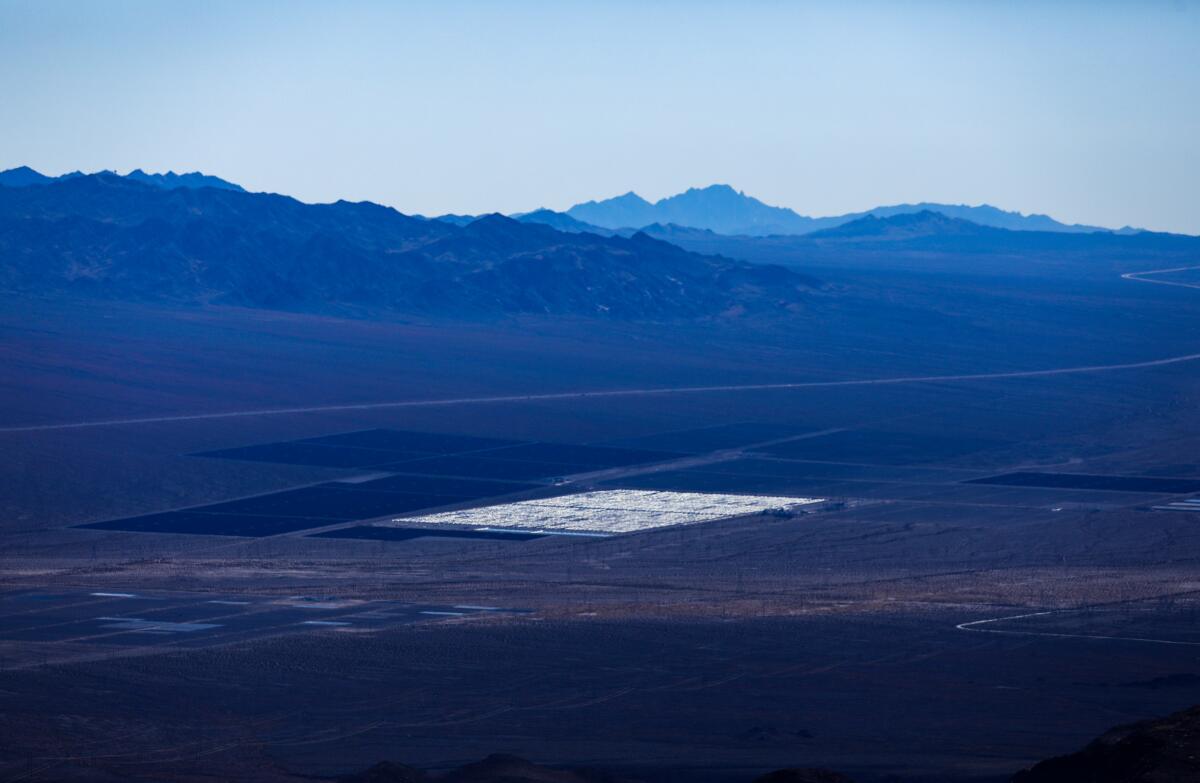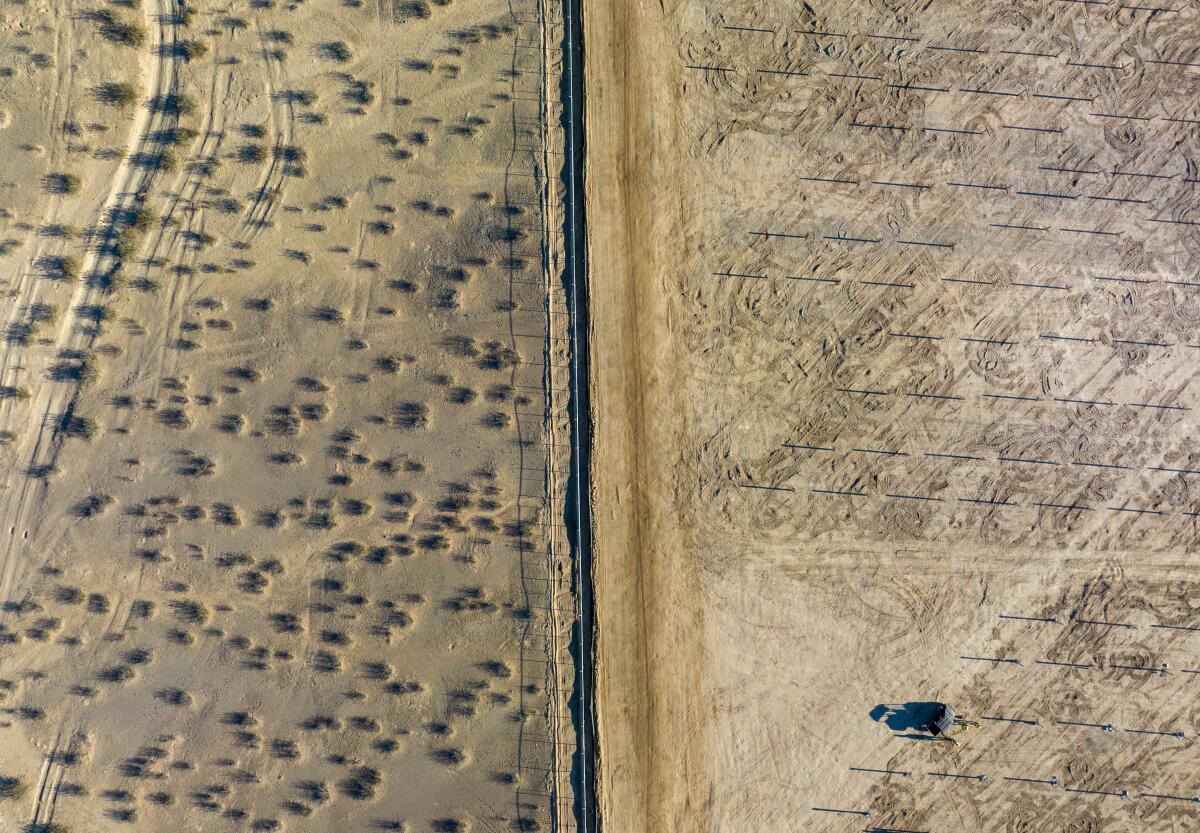There’s no such thing as a perfect climate change solution

- Share via
Good morning, and welcome to the Essential California newsletter. It’s Friday, July 7. I’m Sammy Roth, energy and environment reporter for The Times. I also write our twice-weekly Boiling Point newsletter.
Tackling the climate crisis — which is already fueling deadlier heat waves, more destructive fires and worsening drought in the American West — will require building huge amounts of renewable energy to replace fossil fuels. That’s hardly a secret.
But what happens when climate-friendly energy infrastructure creates environmental damage of its own?
I tried to answer that question in Part 3 of Repowering the West, my ongoing series exploring how the transition to cleaner power is affecting landscapes, ecosystems and communities across the region. Part 3 took me to Nevada, where energy companies have proposed dozens of sprawling solar farms on public lands in the Mojave Desert around Las Vegas — even though there’s loads of space to put solar panels on rooftops and parking lots within Sin City and its suburbs.
[Read “Solar sprawl is tearing up the Mojave Desert. Is there a better way?” in The Times.]
So what gives? Why are we tearing up the desert instead of investing in clean energy within the cities where it’s needed?
The short answer: No one technology or strategy is enough to confront the enormity of the climate crisis.
We burn such large quantities of coal, oil and gas to power society that a wide range of substitutes are needed, researchers have found. If we want to safeguard human civilization without prolonged blackouts or economic disruption, we’ll need wind turbines, solar panels, batteries, geothermal power and almost certainly some nuclear plants and hydropower dams, too.
We’ll also need to drive less, use less energy overall and switch to electric heating and cooking in our homes, scientists say.
With the notable exception of energy efficiency, none of those solutions are pain-free.
Electric appliances are cleaner but more expensive to purchase. Nuclear reactors can generate pollution-free power around the clock, but they’re a source of public concern due to radioactive waste and meltdown risk. Wind turbines kill birds, although not nearly as many as global warming threatens to drive to extinction. Batteries can help keep the lights on after sundown, but they depend on lithium mining that can be environmentally harmful. Electric-vehicle batteries have the same problem.
Large solar farms in the desert, too, are far from perfect.
In Nevada, I saw firsthand the ecosystem destruction that can be wrought by renewable energy projects — and also the efforts undertaken by some companies to build solar farms that preserve habitat for desert tortoises and other wildlife and plants.

I talked with some conservation activists who want to bring renewable energy development to a screeching halt on public lands, and others who simply hope to contain solar projects to the least-sensitive lands. I went off-roading with a motorcycle enthusiast who has seen some of his favorite trails blocked by huge solar fields. I also tried (and failed) to land an interview with billionaire investor Warren Buffett, whose Berkshire Hathaway empire is at the center of this debate, in Nevada and across the West.
And what about rooftop solar, you may be asking?
The more of it gets built, the fewer massive solar installations will be needed in the desert. But we’ve only got so many rooftops and parking lots. As I explained in one of last week’s Boiling Point newsletters, experts say it’s unlikely urban solar systems could supply more than one-quarter or perhaps one-third of U.S. power — even if they’re installed in every suitable spot.
And so we find ourselves in an increasingly dangerous situation, arguing about the merits of different clean energy solutions as the world gets hotter and more chaotic. Those arguments aren’t necessarily a bad thing. We should absolutely be trying to solve climate change while doing as little incidental damage as possible, and while keeping energy costs as low as possible.
But time is running short to phase out fossil fuels. Scientists say we need to cut planet-warming carbon emissions nearly in half by 2030 — just seven years from now. No matter how many times I write that sentence, it still scares the crap out of me.
There’s no perfect climate change solution. But we can’t let the perfect be the enemy of saving life as we know it.
[Read “Solar sprawl is tearing up the Mojave Desert. Is there a better way?” in The Times.]
To keep up with my reporting — and environment news across the West — sign up for our Boiling Point newsletter. And follow along with Repowering the West here, including the captivating mini-documentaries produced by The Times’ video team.
Part 4 of the series, dealing with the pros and cons of hydroelectric dams, is in the works. Stay tuned.
And now, here’s what’s happening across California:
Note: Some of the sites we link to may limit the number of stories you can access without subscribing.
L.A. STORIES
Monday was the hottest day ever recorded on Earth. Then Tuesday was hotter. That’s according to scientists at the University of Maine, who reported that average global temperatures on July 3 and 4 were the highest they’d ever seen, based on data going back to 1979. Worsening heat waves are the deadliest consequence of the climate crisis, and many people probably died of heat-related illness — some of them in Los Angeles County, where temperatures reached 105 degrees. Los Angeles Times
Support our journalism
CLIMATE AND ENVIRONMENT
Residents of California’s San Joaquin Valley are struggling to move forward as farm fields and towns remain flooded by the resurgent Tulare Lake. Times photographer Robert Gauthier and reporter Melissa Gomez compiled captivating stories and portraits of some of the people affected, including a Native American farmer, a Black pastor, two levee repairmen working for the California Conservation Corps and a woman who runs an emergency aid thrift shop. Los Angeles Times
The Chemehuevi Indian Tribe’s reservation fronts about 30 miles of the Colorado River, along the California-Arizona state line. But the tribe can’t access much of its long-promised Colorado River water, with most of its allocation flowing downstream to Southern California cities, including Los Angeles. That’s the takeaway of the latest collaboration between High Country News and ProPublica, exploring how many Western tribes have been denied water to which they’re entitled. High Country News
IN THE COURTS
The California Public Utilities Commission rejected a request to revisit its December decision slashing financial incentives for rooftop solar panels. Rooftop solar advocates may have better hope of success with a lawsuit against the commission, which I wrote about in May. The state agency’s leaders are appointed by Gov. Gavin Newsom. Courthouse News Service
“The opening statements had the makings of a thrilling detective novel. The attorneys promised the jury a dramatic trial that would expose the work of spies, secret inventories, deceitfully written letters and the mysterious theft of a key document from a locked office.” A former UC San Diego oncologist accused of committing fraud and enriching himself via a $10-million donation is on trial after a series of investigations by journalists Jill Castellano and Brad Racino. inewsource
SUMMER IS FOR BASEBALL
The Dodgers desperately need to trade for starting pitching if they want to compete for a championship this year. That’s what The Times’ Bill Plaschke argues in his latest column, which has two exclamation points in the headline, in case you miss the urgent tone. Plaschke is right. I was at Dodger Stadium for Bobby Miller’s victory over the Pirates the other night, and as much as I’m rooting for the team’s talented rookies, they’re not going to be enough to get us through October. Los Angeles Times
“I guess nothing kills faith in your government better than actually paying attention to it.” Times sportswriter Bill Shaikin talked with a 24-year-old Nevada kindergarten teacher who was outraged to see her state’s legislators pledge $380 million for a baseball stadium when they won’t raise teacher salaries. Her experience helps explain why a Nevada teachers’ union is working to block recently approved public funding to entice the Oakland Athletics to move to Las Vegas. Los Angeles Times
Our daily news podcast
If you’re a fan of this newsletter, you’ll love our daily podcast “The Times,” hosted every weekday by columnist Gustavo Arellano, along with reporters from across our newsroom. Go beyond the headlines. Download and listen on our App, subscribe on Apple Podcasts and follow on Spotify.
HOORAY FOR HOLLYWOOD
I still haven’t seen “Game of Thrones,” but it’s a treat watching Emilia Clarke do her thing on “Secret Invasion.” I enjoyed my colleague Tracy Brown’s interview with the actor, in which Clarke explains why she signed up for a Marvel Cinematic Universe television show and shuts down the idea that acting in front of a green screen is not “real” acting. Los Angeles Times
There’s a new Marvel musical at the Disneyland Resort. Times critic Todd Martens writes that “Rogers,” which premiered last week, “has a level of confidence because it knows exactly what it is — a bit of a lark, with some big band dancing and a little bit of heart. Not bad for something that could have forever existed as only a clever joke.” I’m psyched to see it. Los Angeles Times
Free online games
Get our free daily crossword puzzle, sudoku, word search and arcade games in our game center at latimes.com/games.
AND FINALLY
Today’s California landmark is from Eric Sonnenschein of New York: The Getty Center, overlooking the Sepulveda Pass in the Santa Monica Mountains.

Eric writes:
The Getty Center is an extraordinary museum (and landmark) because its landscape and grounds are just about as beautiful as its impressive art collection. We were seated on a bench on a path amid the pond, the flowers, the hedges, the waterfall and the environmental sculptures when I saw a stand of beautiful “flat topped” pink-flowered trees. I had never seen vegetation quite like them. They were so lovely, dignified and sedate — bona fide living art.
What are California’s essential landmarks? Fill out this form to send us your photos of a special spot in California — natural or human-made. Tell us why it’s interesting and what makes it a symbol of life in the Golden State. Please be sure to include only photos taken directly by you. Your submission could be featured in a future edition of the newsletter.
Please let us know what we can do to make this newsletter more useful to you. Send comments to essentialcalifornia@latimes.com.
Sign up for Essential California
The most important California stories and recommendations in your inbox every morning.
You may occasionally receive promotional content from the Los Angeles Times.







